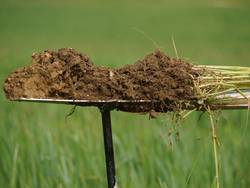New Fertilcrop video on the spade test
Soils are the most valuable resource for crop production, but they receive very little attention because we take them as granted. Within the project FertilCrop, visual soil assessment and other hands-on techniques are compared to analytical soil tests. A new video explains how to apply the spade test.
The spade test can tell you about the top 40 cm of soil, which contains the layer that is manipulated by machinery and the layer below. Many characteristics of a soil can be determined such as horizons or layers, texture, colour, odour, structure, roots, and soil dwelling animals and you can see the effect of soil tillage. The video contains the following chapters:
- Comparison with other methods
- Who should use the spade test?
- Determining the goals and location of the spade test
- How to take a spade sample
- Preparing the sample
- Evaluating the layering
- Evaluating colour and smell
- Handtest for the evaluation of texture
- Evaluating structure
- Determining the calcium content
- Evaluating root growth
- The dropping test
- Evaluating the observations
English version (Slovenian subtitles available): https://www.youtube.com/watch?v=f-kigHj3vbw
German version (Hungarian subtitles available): https://www.youtube.com/watch?v=TEeLeHplhmY
French version: https://www.youtube.com/watch?v=YH63L-lXwE8
Italian version: https://www.youtube.com/watch?v=_AHtkofn8Yw
A well-structured soil provides a porous substrate that can hold water, let the air penetrate and make nutrients available to plants. Soil takes up and stores water between the rains and provides a porous structure that plant roots can penetrate to take up nutrients. Plants can only grow if they find water and nutrients in the soil, and vice versa they provide the residues to build up organic matter or humus.
Humus is helping to build stable soil structures like crumbs that are hot spots of soil life. A handful of soil may contain far more organisms than humans on earth. They are the decomposers and play a key role in recycling the nutrients that are bound in the organic residues or fertilizers. When we talk about soil, we talk about terrestrial life.
Soils have developed over millions of years, however they can be destroyed by a single stroke. Let us give attention to the soil and care about the earth’s skin. We just need to develop our senses and curiosity to explore this fascinating world down-under. Please dig a hole and look.
Further information
Contact
Andreas Fliessbach, Coordinator FertilCrop
Links
- bioaktuell.ch: Further information including chapters in French
- bioaktuell.ch: Further information including chapters in German
 This website was archived on January 11, 2020 and is no longer updated.
This website was archived on January 11, 2020 and is no longer updated.

